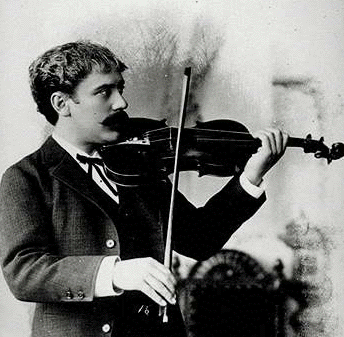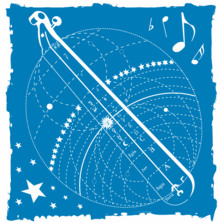Mozart's Magic - The Sonatas for Piano and Violin
I am currently in a two-week long residency at a young artist’s program in the Midwest, coaching twelve students in a variety of sonatas for violin and piano by Mozart. The participants are between the ages of ten and about seventeen, and I worked with quite a few of them last summer. Each has been assigned a sonata and, out of the lot, only a couple have duplicate assignments so I am hearing ten different sonatas.
It has been something of a revelation. Although I have played a number of these works over the years, hearing them in such close proximity reminds me of Mozart’s absolute genius, on a multitude of
levels.
In some of the Sonatas the violin and piano are equally prominent, in others the violin plays more of an accompanimental role, often playing the equivalent of a bassoon part if the work were orchestrated. The variety of moods (or affects) of these works is remarkable; the first movement of the Sonata (KV 293b) in E-flat Major has a grand nobility followed by a Rondo that is incredibly warm and intimately songful. One of my favorite aspects of this particular Sonata occurs shortly after its opening, which features a crescendo that is extremely reminiscent – along with the key signature – of the Sinfonia Concertante composed in 1779. Sure enough, we see that this work was composed in Mannheim in February of the previous year, a time when the local orchestra was renowned for its “crescendo.”
Another work from that same period is the Sonata in A Major, KV 293a, which brings back an amazing memory from when I was eighteen and moved to Belgium to study with Arthur Grumiaux. My studies with him began at a two-week summer master class program in Namur, so I had just arrived in a foreign country and was away from everything that was familiar. This move had also led to quite a rift – not only with my previous violin teacher but also my mother – so I really felt alone, there was no financial support, and I had to count every franc in order to stave off financial trouble as long as possible. My private lessons were going to cost the then-equivalent of about $150 each (maybe $350 in current dollars?), so I had to scrimp severely. The whole stituation led me to feel quite anxious.I was sitting in the darkened recital hall where the master class took place, along with perhaps six other students, when it came time for Janet Haugland to play. She had already been working with the Maitre for an extended period and was going to play this sonata. Grumiaux said something to the pianist for the class, who then left the stage, and sat down at the piano to play. His delight in playing this work was palpable – and he was a truly marvelous pianist. The beautiful music and his pianism left me feeling amazed, nearly giddy, and probably a bit jealous as I didn’t know yet how he was going to respond to me.The second movement of this sonata is a lovely Theme and Variations with a tempo of Andante grazioso. Even its begining is extremely special, as Mozart indicates an upbeat trill but specifies a starting appogiatura that is the same pitch as the principal note of the trill – something that an interpretor probably wouldn’t do otherwise – and the effect is magical. The rest of the movement is no less special, with each variation providing its own affect (including one in A minor that reminds me of a villain tiptoeing around in a comical way!)
I am also coaching the Sonata in G Major, KV 293a, whose heartfelt simplicity demands the utmost purity in phrasing and expression as there is little that is overtly “virtuosic” in the writing.
Two students are studying the Sonata in E Minor, KV 304. Of all of his violin sonatas, this is perhaps the most difficult to bring off in public performance as it reflects the sadness, nostalgia, and anger that Mozart felt shortly following his mother’s death in 1778. The second movement is a wistful Minuet that is characterized by amazingly delicate but profound shifts of mood, none more so than the relatively brief section in E Major in which he indicates, for both players, an expressive portato sound. Out of all of his compositions, Mozart apparently used this key signature only one other time and his use of minor keys throughout these Sonatas is sparing.
Because the Sonatas were composed while the fortepiano’s sustaining pedal was still being perfected, Mozart generally wrote dynamics that are terraced – in the manner of music for harpsichord – although there are some indications of crescendi, decrescendi and even the occasional “mezzoforte.” One of the Sonatas is almost devoid of dynamic indicators. I have been encouraging the students to be consistently aware of the level of rhythmic activity in both their parts and that of the piano, as that is one of the best ways to figure out a dynamic scheme that is appropriate to the music and gesture; i.e., if the music is brilliant, then the dynamic level is higher.
Another factor in playing these works is that of articulation. The demands placed on the violinist’s left hand are not simple in Mozart’s music, especially in purity of intonation and use of vibrato, but those placed on the bowing are much more sophisticated and require a large “vocabulary” of articulation, applied with great finesse. A series of notes that are under a legato line should contrast markedly with separate notes; in the Allegro movements the bow speed often should be the quickest at the very start of a note, in order to balance well with the pianist’s articulation and energy – otherwise the violinist can sound somewhat lazy and unrhythmic.
Unfortunately. even the Urtext editions by Henle and Barenreiter often overlook an important articulation: the stroke, which is sometimes called the carrot, wedge, or keil. The editors of a number of “Urtext” works apparently have arrived at the mistaken belief that a stroke is really a staccato dot; however, one can see in autographs – such as those of Mozart’s Violin Concerti and Beethoven’s Violin Concerto – that there is a distinction in notation between the dot and stroke.
Having studied many contexts in which I know, reliably, that an articulation mark is indeed a stroke, I have come to the conclusion that a stroke indicates a note that has both melodic and rhythmic significance. It may be in the part of a meter that normally would be lighter, such as an offbeat or the third beat in a three-based meter, and is the composer’s sign that the note carries an important role. Rarely should it be played with harshness, as is (unfortunately) often the case. The same is true of the FP (fortepiano) marking, which indicates a sound that begins strongly and ends weakly and may modify a note or phrase of several beats rather than an abrupt accent at the start of a note.
One of the best pieces of advice I have seen regarding Mozart’s ornaments is found in Frederick Neumann’s book “Ornamentation and Improvisation in Mozart.” He gives many examples of suggested realizations of different kinds of grace notes, turns and trills, but ultimately tells the interpreter to use her ear. If the principal note is enhanced and sounds more graceful, the execution is successful!
Mozart is also a master of the unexpected, whether in insistently (and, often, comically) repeating a part of a cadence or by having us play forte and moving on to new material when the ear is expecting an ending cadence in piano. Often, both the violinists and pianists gloss over the cadence’s end-note and hurry into the unexpected part, and I remind them (and myself) that it is important to stay “in the moment” and complete the cadence as if there is no surprise coming up, in order not to give it away.
Finally, I try to impart the idea that silence is as meaningful as sound: whether it occurs as rests in the midst of a passge or at the end of the composition, the silence is always to be acknowledged.
One of the pianists and I briefly talked about the fact that some of the Sonatas have but two movements while others have three, and we agreed that Mozart knew when to stop; that he had already achieved perfection in the balance of two movements. In the process of working with the students here, I feel that my own interpretations have been enhanced and look forward to my own future experiences with this music, the delights and insights of which remain timeless.



















